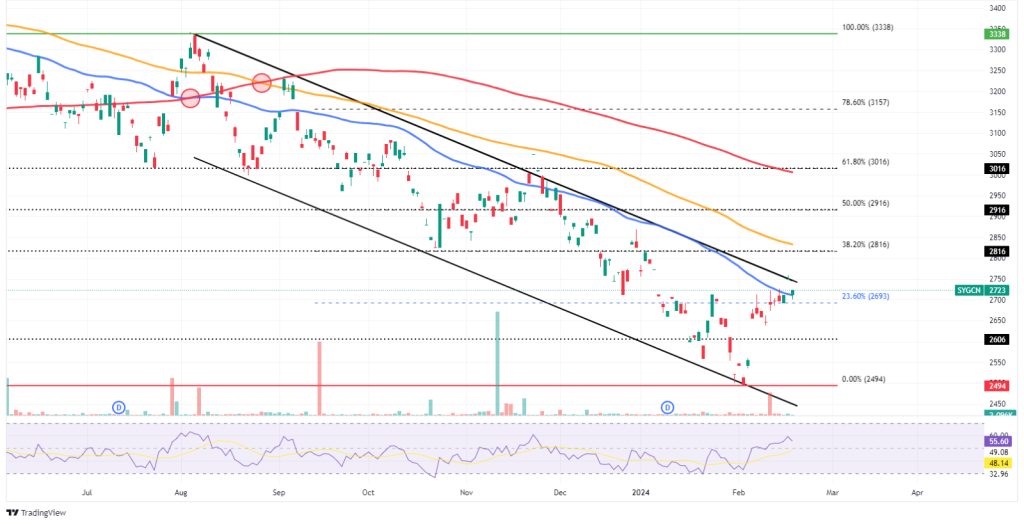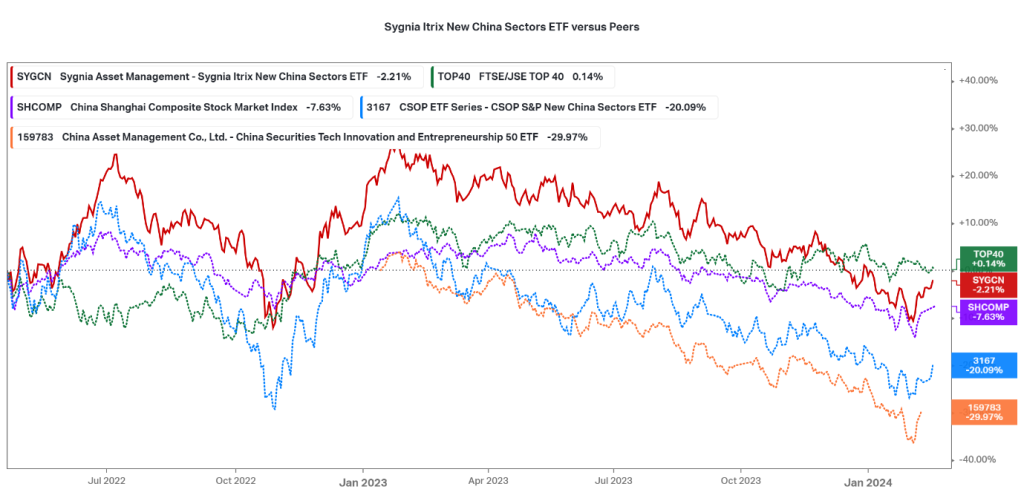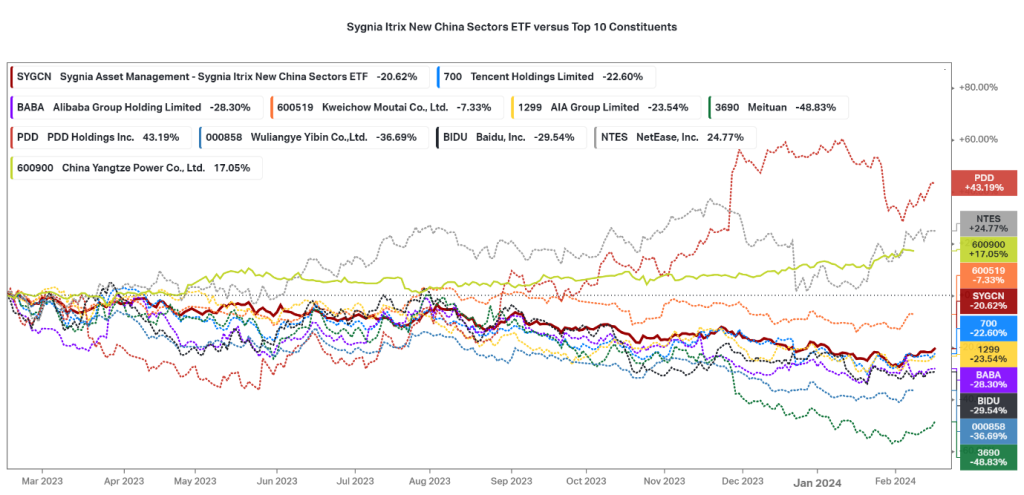
The Sygnia Itrix New China Sectors ETF (JSE: SYGCN) has faced a challenging year, aligning with the broader struggles of the Chinese markets and uncertainties within the New China sphere. As of February 19, 2024, the ETF is down over 2% year-to-date, leading its benchmark, the S&P New China Sectors Index, which has declined over 4% year-to-date.
Technical
The 1-day chart of SYGCN reveals a slight recovery within a descending channel trading pattern. Currently, the share price hovers around the 50-SMA within the channel, indicating a potential rebound from recent declines. The price has recently broken above the downward-sloping 50-SMA (blue line) but remains below the 100-SMA (orange line) and 200-SMA (red line), highlighting the dominant bearish sentiment. The Relative Strength Index (RSI) trades tentatively above the 50.00 level, suggesting a potential break out of oversold territory.
A sustained break above the channel’s resistance at 2,816 cents could trigger further upward momentum towards the 38.20% Fibonacci retracement level at 2,916 cents and the 50.00% Fibonacci retracement level at 3,016 cents. Conversely, a failure to sustain a push higher and a break below the 23.60% Fibonacci retracement level may offer short-term trading opportunities towards the initial support at 2,606 cents, with the next significant level at 2,494 cents.

Fundamental
SYGCN’s recent underperformance needs to be contextualized within the broader market and industry dynamics. Broader market sell-offs, driven by global concerns about inflation, rising interest rates, and a potential economic slowdown, have impacted the ETF. China-specific challenges, including a slowdown in the property sector and regulatory crackdowns, have dampened investor sentiment towards Chinese equities, influencing SYGCN.
The ETF’s sector allocation, focusing on consumption- and service-oriented industries in China and Hong Kong, exposes it to challenges such as economic slowdown, regulatory scrutiny, and geopolitical tensions.

Source: Trive Financials – Koyfin, Mfanafuthi Mhlongo
While the technical picture offers a tentative glimpse of hope, the fundamental landscape paints a more complex picture. SYGCN’s underperformance compared to its peers like the CSOP S&P New China Sectors ETF (down 4.36%) and the China Securities Tech Innovation and Entrepreneurship 50 ETF (down 9.26%) highlights broader issues faced by the Asian economies and the specific challenges faced by the “new economy” sector.
- China’s Economic Headwinds: A slowdown in the Chinese economy, fueled by property market woes and a deflationary environment, has cast a shadow on consumption and service-oriented sectors, SYGCN’s primary focus.
- Regulatory Uncertainty: The ongoing regulatory crackdown on various sectors, including technology and education, has dampened investor sentiment and restricted growth opportunities for companies within SYGCN’s portfolio.
- Geopolitical Tensions: Heightened tensions, particularly concerns about China’s territorial ambitions, have added to investor uncertainty and risk aversion towards Chinese assets.
- Sectoral Exposure: SYGCN’s heavier allocation to consumer discretionary and communication services sectors, compared to its peers, exposes it more acutely to the headwinds mentioned above.

Source: Trive Financials – Koyfin, Mfanafuthi Mhlongo
SYGCN’s year-to-date decline of 20.62% reflects a tumultuous year for the “new economy” in China. While the ETF itself outperforms the underperforming benchmark (S&P New China Sectors Index), a closer look at its top 10 constituents reveals a diverse performance landscape, painting a picture of the complex forces impacting Chinese equities.
Only two of the top 10 holdings escaped negative returns: PDD Holdings (up 43.19%) and NetEase (up 24.77%). This divergence highlights the sector-specific and company-specific factors at play. PDD’s success can be partially attributed to its focus on lower-tier cities and live-streaming commerce, areas still showing growth potential. NetEase benefited from strong performance in its online games and music streaming segments.
Tech giants Tencent (-22.26%), Alibaba (-28.3%), Meituan (-48.83%), and Baidu (-29.54%) have been hit by regulatory crackdowns, concerns about slowing internet penetration, and broader tech sell-off contributed to their declines. Meanwhile, consumer discretionary companies such as AIA Group (-23.54%) and Wuliangye Yibin (-36.69%) declined due to concerns over a potential economic slowdown and declining consumer confidence, which have heavily impacted these sectors.
Summary
SYGCN offers exposure to the “New China” economy, a potentially high-growth engine. However, the current landscape is fraught with risks. While a technical upswing offers a glimmer of hope, fundamental factors suggest a challenging road ahead.
Sources: TradingView, KoyFin, Business Insider, CleanFinance, MSCI, Sygnia.
Piece written by Mfanafuthi Mhlongo, Trive Financial Market Analyst
Disclaimer: Trive South Africa (Pty) Ltd (hereinafter referred to as “Trive SA”), with registration number 2005/011130/07, is an authorised Financial Services Provider in terms of the Financial Advisory and Intermediary Services Act, 37 of 2002. Trive SA is authorised and regulated by the South African Financial Sector Conduct Authority (FSCA) and holds FSP number 27231. Trive Financial Services Ltd (hereinafter referred to as “Trive MU”) holds an Investment Dealer (Full-Service Dealer, excluding Underwriting) Licence with licence number GB21026295 pursuant to section 29 of the Securities Act 2005, Rule 4 of the Securities Rules 2007, and the Financial Services Rules 2008. Trive MU is authorized and regulated by the Mauritius Financial Services Commission (FSC) and holds Global Business Licence number GB21026295 under Section 72(6) of the Financial Services Act. Trive SA and Trive MU are collectively known and referred to as “Trive Africa”.
Market and economic conditions are subject to sudden change which may have a material impact on the outcome of financial instruments and may not be suitable for all investors. Trive Africa and its employees assume no liability for any loss or damage (direct, indirect, consequential, or inconsequential) that may be suffered. Please consider the risks involved before you trade or invest. All trades on the Trive Africa platform are subject to the legal terms and conditions to which you agree to be bound. Brand Logos are owned by the respective companies and not by Trive Africa. The use of a company’s brand logo does not represent an endorsement of Trive Africa by the company, nor an endorsement of the company by Trive Africa, nor does it necessarily imply any contractual relationship. Images are for illustrative purposes only and past performance is not necessarily an indication of future performance. No services are offered to stateless persons, persons under the age of 18 years, persons and/or residents of sanctioned countries or any other jurisdiction where the distribution of leveraged instruments is prohibited, and citizens of any state or country where it may be against the law of that country to trade with a South African and/or Mauritius based company and/or where the services are not made available by Trive Africa to hold an account with us. In any case, above all, it is your responsibility to avoid contravening any legislation in the country from where you are at the time.
CFDs and other margin products are complex instruments and come with a high risk of losing money rapidly due to leverage. You should consider whether you understand how these products work and whether you can afford to take the high risk of losing your money. Professional clients can lose more than they deposit. See our full Risk Disclosure and Terms of Business for further details. Some or all of the services and products are not offered to citizens or residents of certain jurisdictions where international sanctions or local regulatory requirements restrict or prohibit them.




